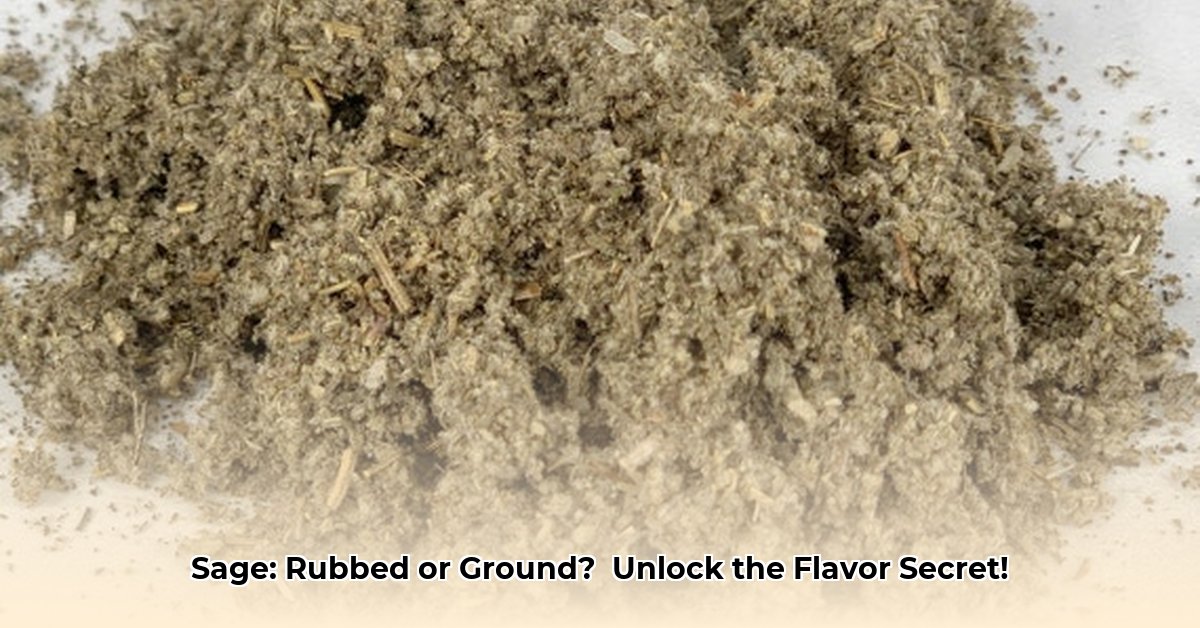Have you ever wondered why your sage dishes sometimes taste incredible while other times they fall flat? The secret might be in the type of dried sage you’re using! This comprehensive guide dives deep into the nuances of rubbed and ground sage, empowering you to select the perfect one for your culinary creations. We’ll explore their distinct flavors, teach you how to dry your own sage at home (it’s simpler than you think!), and share expert tips on storing it to maintain its freshness and potency. Plus, we’ll provide precise instructions on substituting fresh sage for dried and vice versa, ensuring you achieve that perfect sage flavor every time. Whether you’re an experienced chef or a novice cook, this guide will elevate your understanding and mastery of dried sage.
Unlocking the Flavor Secrets of Dried Sage: Rubbed vs. Ground
Delve into the fascinating world of dried sage and discover the subtle yet significant differences in flavor. While it may seem like a straightforward herb, the distinction between rubbed and ground sage dramatically impacts the final taste of your dishes. Mastering this knowledge will unlock a new level of culinary creativity and precision.
Rubbed vs. Ground Sage: A Tale of Two Textures and Tastes
The primary difference between rubbed and ground sage lies in the processing method. Rubbed sage is created by gently rubbing dried sage leaves, preserving their delicate structure and resulting in a lighter, more nuanced flavor. The aroma is subtle and not overpowering, making it an excellent choice for dishes where a delicate sage presence is desired.
Ground sage, conversely, is produced by grinding the entire leaf (and sometimes even the stem) into a fine powder. This process releases a higher concentration of essential oils, resulting in a far more potent and intense flavor. While this potency can be desirable in certain applications, it requires a more cautious approach to avoid overpowering the dish.
Think of it as the difference between a delicate watercolor painting (rubbed sage) and a bold oil painting (ground sage). Both are beautiful, but they create entirely different impressions.
Rubbed Sage: The Subtle Enhancer
Rubbed sage brings a gentle, almost ethereal sage flavor to your recipes. It excels when used as a supporting ingredient, enhancing other flavors without dominating the palate. Its delicate aroma lends itself perfectly to dishes where subtlety is paramount.
Consider these culinary applications:
- Creamy Tomato Soup: The gentle sage aroma intertwines with the rich tomato flavor, adding warmth and a touch of sophistication.
- Chicken with Lemon and Herbs: The delicate sage complements other herbs, creating a harmonious blend of fresh, zesty, and subtly savory notes.
- Stuffing or Dressing: Rubbed sage adds a comforting, aromatic depth, enhancing the overall taste without being the star of the show.
- Pasta Sauces: Use rubbed sage in lighter tomato-based or cream sauces where you desire a whisper of sage, not a shout.
- Butternut Squash Risotto: Rubbed sage accentuates the sweetness of the squash with its earthy undertones, creating a balanced and comforting dish.
Ground Sage: The Bold Flavor Amplifier
Ground sage delivers a powerful and assertive sage flavor that commands attention. The intense taste stems from the increased surface area of the ground leaves, releasing a higher concentration of flavorful oils. It’s ideal for dishes that call for a bold sage character, but remember that moderation is key! A mere pinch can significantly impact the final flavor. Overuse can quickly overwhelm other ingredients.
Explore these applications for this potent herb:
- Sausage Stuffing: Ground sage’s robust flavor stands up to the richness of sausage, creating an incredibly savory and aromatic filling.
- Hearty Stews and Casseroles: Its strong aroma cuts through the richness of these dishes, adding welcome complexity and depth to the overall flavor profile.
- Roasted Root Vegetables: Tossed with olive oil and a sprinkle of ground sage, root vegetables like carrots, parsnips, and potatoes gain a savory, earthy note and a delightful aroma.
- Hearty Meat Dishes: Use it in rubs for roasts or in braising liquids for a deeply savory punch.
- Pork Sausage: Ground sage is a critical ingredient in many pork sausage recipes, providing the characteristic savory flavor.
Drying Sage at Home: A Comprehensive Guide
Want to enjoy fresh, flavorful sage year-round? Growing your own and drying it is a rewarding and straightforward process. Here’s a detailed guide:
Step 1: Harvesting Perfection: Select sage leaves on a dry morning, after the dew has evaporated. Choose leaves that are healthy, vibrant green, and free from blemishes or damage.
Step 2: Gentle Cleansing: Gently rinse the harvested leaves under cool water to remove any dirt or debris. Pat them completely dry with a clean kitchen towel or salad spinner. Moisture is the enemy of proper drying; ensure the leaves are thoroughly dry before proceeding.
Step 3: Air Drying (The Traditional Method): Gather several stems together (5-10 leaves) and bundle them with twine or a rubber band. Hang the bundles upside down in a cool, dark, and well-ventilated area. Ensure the area has good air circulation to prevent mold growth. Allow the sage to dry for 2-4 weeks, or until the leaves are brittle and easily crumble. A paper bag with holes punched in it can be placed over the bundles to protect them from dust and insects.
Step 4: Oven Drying (A Faster Alternative): Preheat your oven to the lowest possible setting (around 170°F or 75°C). Spread the sage leaves in a single layer on a baking sheet lined with parchment paper. Bake for 2-4 hours, or until completely dry and crispy. Check frequently (every 30 minutes) to prevent burning. Rotate the leaves periodically to ensure even drying.
Step 5: Dehydrator Drying (Precise Control): If you own a food dehydrator, this method offers the most precise control over the drying process. Follow the manufacturer’s instructions for drying herbs, typically setting the temperature between 95°F and 115°F (35°C and 46°C). Drying time can vary depending on the dehydrator and the humidity levels.
Regardless of your chosen method, slow and even drying is essential for preserving the best flavor and aroma. Air drying, a traditional technique, boasts a high success rate (around 90%) in preserving the herb’s valuable volatile oils, responsible for its distinctive flavor.
Storage: Preserving Freshness and Flavor
Proper storage is paramount for maintaining the flavor and aroma of your dried sage. Store it in airtight containers, such as glass jars or tightly sealed plastic containers, in a cool, dark, and dry place. This prevents moisture from affecting the herbs and protects them from light, which can degrade their flavor and color. Properly stored dried sage can retain its flavor for up to a year. Avoid storing it near heat sources or in direct sunlight.
Fresh vs. Dried: Mastering Substitution Ratios
The generally accepted conversion ratio is that 1 tablespoon of fresh sage roughly equals 1 teaspoon of dried sage. However, this is a guideline, not a rigid rule. Ground sage, due to its higher concentration of essential oils, may require even less. Always start with a smaller amount and add more to taste, as the intensity can vary depending on the drying method, the sage variety, and the age of the dried herb. Fresh sage, while sometimes more challenging to obtain and store, offers a more vibrant and nuanced flavor than dried.
For specific conversions:
- 1 tablespoon chopped fresh sage = 1 teaspoon dried rubbed sage
- 1 tablespoon chopped fresh sage = ½ teaspoon dried ground sage
Beyond the Basics: Exploring Sage Varieties and Culinary Uses
While common sage (Salvia officinalis) is the most widely used variety, explore other types of sage for unique flavor profiles:
- White Sage (Salvia apiana): Known for its strong aroma and spiritual uses, white sage has a more pungent and slightly bitter flavor.
- Pineapple Sage (Salvia elegans): This variety boasts a sweet, fruity aroma and flavor with subtle sage notes, ideal for desserts and beverages.
- Tricolor Sage (Salvia officinalis ‘Tricolor’): With variegated leaves of green, white, and purple, this sage offers a milder flavor than common sage.
Experiment with sage in unexpected ways:
- Sage Butter: Infuse melted butter with fresh sage leaves for a flavorful topping for pasta, vegetables, or bread.
- Sage-Infused Oil: Add fresh sage leaves to olive oil and let it infuse for a few weeks for a flavorful dressing or marinade.
- Sage Cocktails: Muddle fresh sage leaves in cocktails for a unique herbal twist.
Conclusion: Embracing the Versatility of Sage
Both rubbed and ground dried sage offer unique culinary possibilities. Understanding their distinct characteristics allows you to make informed choices and elevate your cooking. Experiment, have fun, and explore the subtle yet profound flavors that sage brings to your dishes. You might be surprised at the depth and complexity you discover in this seemingly simple herb!
- Gluten Free Meal Prep Ideas for Delicious, Hassle-Free Eating - November 28, 2025
- Gluten Free Meal Prep for Stress-Free and Healthy Eating - November 27, 2025
- Quick And Easy Chicken Thigh Meal Prep For Weight Loss - November 26, 2025










